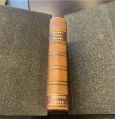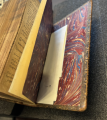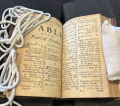Queen's Closet Opened: Difference between revisions
| Line 12: | Line 12: | ||
=== Historical Context === | === Historical Context === | ||
The [https://en.wikipedia.org/wiki/English_Civil_War English Civil Wars], which lasted from 1642 to 1651, took place in the British Isles between supporters of [https://en.wikipedia.org/wiki/Charles_I_of_England King Charles I], known as Royalists or [https://www.britannica.com/topic/cavalier-English-horseman Cavaliers] , and opposing groups, known as Parliamentarians or [https://www.britannica.com/topic/Roundhead Roundheads]. <ref name="brit" > J. Ohlmeyer, “English Civil Wars”, (Britannica ( Apr. 2024)), https://www.britannica.com/event/English-Civil-Wars </ref> The war is believed to have begun because of tension between the king and Parliament. King Charles I raised an army in opposition to the desires of Parliament. Discontent also arose concerning the king's exercise of authority, his economic strategies, and differences in religious beliefs. <ref name="brit" > J. Ohlmeyer, “English Civil Wars”, (Britannica ( Apr. 2024)), https://www.britannica.com/event/English-Civil-Wars </ref> After many battles the Parliamentarians emerged victorious and King Charles I was executed in January 1649 for treason and crimes against England. <ref name="brit" > J. Ohlmeyer, “English Civil Wars”, (Britannica ( Apr. 2024)), https://www.britannica.com/event/English-Civil-Wars </ref>The execution provoked the Scottish support for King Charles I’s son, [https://en.wikipedia.org/wiki/Charles_II_of_England#:~:text=Charles%20II%20 Charles II ], who was crowned king of Scotland. After the execution [https://en.wikipedia.org/wiki/Oliver_Cromwell Oliver Cromwell] served as [https://en.wikipedia.org/wiki/Lord_Protector Lord Protector] until his death in September 1658. Cromwell was the incumbent of England when the book was first published in 1655 and the life of the aristocracy was fascinating to many. <ref> Anon, “1713 The Queens Closet Opened, In Three Parts Part I Containing above five Hundred Choice Physical and Chirurgical Receipts”, (Rookebooks), https://www.rookebooks.com/1713-the-queen-s-closet-opened-in-three-parts </ref> The book is thought to have been published in response to the scandalous exposure of ''The King's Cabinet Opened'', which was published in 1645. <ref name="k" >L. Knoppers, “Opening the Queen’s Closet: Henrietta Maria, Elizabeth Cromwell, and the Politics of Cookery”, (Renaissance Quarterly, Vol. 60, No. 2 (Summer 2007), pp. 464-499.) </ref> In these times aristocratic families were frequently featured in literature, art, and theater. Amidst the chaos, the lavish lifestyles of aristocrats were a subject of admiration and curiosity among the common people. | The [https://en.wikipedia.org/wiki/English_Civil_War English Civil Wars], which lasted from 1642 to 1651, took place in the British Isles between supporters of [https://en.wikipedia.org/wiki/Charles_I_of_England King Charles I], known as Royalists or [https://www.britannica.com/topic/cavalier-English-horseman Cavaliers] , and opposing groups, known as Parliamentarians or [https://www.britannica.com/topic/Roundhead Roundheads]. <ref name="brit" > J. Ohlmeyer, “English Civil Wars”, (Britannica ( Apr. 2024)), https://www.britannica.com/event/English-Civil-Wars </ref> The war is believed to have begun because of tension between the king and Parliament. King Charles I raised an army in opposition to the desires of Parliament. Discontent also arose concerning the king's exercise of authority, his economic strategies, and differences in religious beliefs. <ref name="brit" > J. Ohlmeyer, “English Civil Wars”, (Britannica ( Apr. 2024)), https://www.britannica.com/event/English-Civil-Wars </ref> After many battles the Parliamentarians emerged victorious and King Charles I was executed in January 1649 for treason and crimes against England. <ref name="brit" > J. Ohlmeyer, “English Civil Wars”, (Britannica ( Apr. 2024)), https://www.britannica.com/event/English-Civil-Wars </ref>The execution provoked the Scottish support for King Charles I’s son, [https://en.wikipedia.org/wiki/Charles_II_of_England#:~:text=Charles%20II%20 Charles II ], who was crowned king of Scotland. After the execution [https://en.wikipedia.org/wiki/Oliver_Cromwell Oliver Cromwell] served as [https://en.wikipedia.org/wiki/Lord_Protector Lord Protector] until his death in September 1658. <ref name="brit" > J. Ohlmeyer, “English Civil Wars”, (Britannica ( Apr. 2024)), https://www.britannica.com/event/English-Civil-Wars </ref> Cromwell was the incumbent of England when the book was first published in 1655 and the life of the aristocracy was fascinating to many. <ref> Anon, “1713 The Queens Closet Opened, In Three Parts Part I Containing above five Hundred Choice Physical and Chirurgical Receipts”, (Rookebooks), https://www.rookebooks.com/1713-the-queen-s-closet-opened-in-three-parts </ref> The book is thought to have been published in response to the scandalous exposure of ''The King's Cabinet Opened'', which was published in 1645. <ref name="k" >L. Knoppers, “Opening the Queen’s Closet: Henrietta Maria, Elizabeth Cromwell, and the Politics of Cookery”, (Renaissance Quarterly, Vol. 60, No. 2 (Summer 2007), pp. 464-499.) </ref> In these times aristocratic families were frequently featured in literature, art, and theater. Amidst the chaos, the lavish lifestyles of aristocrats were a subject of admiration and curiosity among the common people. | ||
=== Content === | === Content === | ||
Revision as of 19:02, 5 May 2024

The Queen's Closet Opened is an anonymously written book originating from the kitchen of Henrietta Maria , the wife of King Charles I. It includes customs and recipes of the old aristocracy. Originally, it was published in 1655 England after the execution of King Charles I and there are multiple editions. The recipe book was republished in 1656, 1658, 1659, 1661, 1662, 1663, 1668, 1671, 1674, 1679, 1683, 1684, 1696, 1698, 1710, 1713 and 1726 with edits and additions. The edition in the images is the 11th edition, published in 1710. It contains three parts: Part I: “The Pearl of Practice” (127 pages) , Part II: “A QUEEN’s Delight” (240 pages), Part III: “ The Compleat Cook:” (138 pages).
Background
Recipe Books
The first recorded recipe book is said to be four clay tablets from 1700 BC. [1] Scholars, however, recognize The Forme of Cury created by cooks of Richard II, in 1390 as one of the first English recipe books. It was not until the sixteenth century when the publication of recipe books increased in popularity. [2] They were guidelines for women to manage their households successfully. Women began to cook and were seen as housekeepers rather than nurses and personal servants. [3] Recipe books became prevalent from women sharing their knowledge with their children using these manuscripts. [3] This change endured into the following centuries, seeing a notable rise in printing and distribution of recipe books. These books not only depict the food eaten during the century, but also provide insights into society. [4]
Historical Context
The English Civil Wars, which lasted from 1642 to 1651, took place in the British Isles between supporters of King Charles I, known as Royalists or Cavaliers , and opposing groups, known as Parliamentarians or Roundheads. [5] The war is believed to have begun because of tension between the king and Parliament. King Charles I raised an army in opposition to the desires of Parliament. Discontent also arose concerning the king's exercise of authority, his economic strategies, and differences in religious beliefs. [5] After many battles the Parliamentarians emerged victorious and King Charles I was executed in January 1649 for treason and crimes against England. [5]The execution provoked the Scottish support for King Charles I’s son, Charles II , who was crowned king of Scotland. After the execution Oliver Cromwell served as Lord Protector until his death in September 1658. [5] Cromwell was the incumbent of England when the book was first published in 1655 and the life of the aristocracy was fascinating to many. [6] The book is thought to have been published in response to the scandalous exposure of The King's Cabinet Opened, which was published in 1645. [7] In these times aristocratic families were frequently featured in literature, art, and theater. Amidst the chaos, the lavish lifestyles of aristocrats were a subject of admiration and curiosity among the common people.
Content
The Queen's Closet Opened tells us about the culinary world of seventeenth century England, providing insight into techniques and ingredients “used” by aristocrats. The book transformed foreign ingredients and brought them into English cooking. [7] The title " The Compleat Cook"underscores the use of international cuisine and assimilation of foreign techniques. [7] Organized into three sections including medicinal, confectionary, and culinary recipes, the book presents a diverse array of creations. Despite the titles suggesting insights into the queen, the recipes reveal little to nothing about her. The recipes focus on easy everyday culinary techniques/practices rather than extravagant feasts for royalty. [7] Some recipes contained exotic ingredients such as saffron and gum dragon, but most of them featured ordinary ingredients that were widely available and commonly used in the mid-seventeenth century. [7] Overall, the book neglects to mention the Queen’s preferences or practices despite its title.

Language
All of the recipes are concise, making them easy to follow and share. For example in Part I: The Pearl of Practice “To make a Gafcoin-Powder.” readers are told to “Take the black tips of Crabs-claw…pick out from within them all the Fifh; and beat it to as fine as Powder as you can…”. The titles of many recipes are to the point, such as For the Teeth and To cure the Tooth Ach., as shown on the image on the right. The longer recipes have a bit more detail, but they are similar to the shorter ones with concise language.
Author & Publisher
The author and editor of the book is thought to have been Walter Montagu the Queen’s long-time friend and courtier because the book is signed W.M.. [8] He is best known for his play The Shepheards Paradise . It was performed by Queen Henrietta Maria and a cast of courtier women in 1633. [9] The true author is unknown.
This book was printed for J. Phillips, H. Rhodes, and J. Taylor. They published various literary works including poetry, dictionaries, plays, fables, political pamphlets, etc.
The first edition (1655) of the book was published in London and printed for Nathaniel Brook at the Angel in Cornhill. Nathanial Brook was a British bookseller and publisher found on few prints.
Provenance
Esther B. Aresty, a cookbook collector and culinary historian, and her husband, Julian Aresty, donated her collection of rare cookbooks and cookery manuscripts to the University of Pennsylvania in 1996. Ester Aresty wrote on cooking, cookbooks, cuisine, and etiquette. Her collection spans of five centuries including 577 printed titles, thirteen manuscript cookbooks, and a collection of her papers. [10]
Physical Analysis
Substrate / Binding
The cover is made of thick cardboard wrapped with a thin layer of leather. The book was rebound, as the binding looks new and is made of leather. There are border designs on the cover imprinted into the leather and around the edges of the front and back covers. Possible burn stamps or black paint designs are on edges of the cover around flap and on all other edges. When carefully observed inside the front cover and back cover and all edges of the book you can see the black imprinted designs. Other editions of the book are shown with a similar bindings. The first edition found on Biblio is a much thicker book that looks bound by a hard cover wrapped in leather. A later edition found on Rooke Books from 1713 has a full cloth binding.
-
Binding
-
Bottom view
-
Side view
-
Inside front cover
-
Inside back cover
Paratexts
There are a few sentences under the title of each of the three sections indicating what the book is about. There are different typefaces used in the title page, each of the lines have a different typeface or alternating typefaces. The size and typeface of the cover titles are different from the main text throughout the book. The different typefaces were likely used to keep readers engaged and to aid readers in distinguishing different sections of the book.
The 1713 edition found on Rooke Books shows a cover page titled "The Queen's Closet Opened, In Three Parts. Part I. Containing about Five Hundred choice Phyfical and Chirugical Receipts. Part II. Shewing how... Part III. The Compleat Court and Country Cook;..." This first page includes identically worded descriptions and additional content of each part found on the cover pages of each of the three sections within the book.
-
The first page
-
Cover page of Part III: “The Compleat Cook:”
-
Pg 12-13 of “The Pearl of Practice”
The book has a title page for each of the three parts and labeled page numbers. Each new section starts with new page numbers and all parts have a table of contents in the back to help the reader navigate specifics. Each new recipe has a heading/title that is included in the table of contents. The table of contents is also in alphabetical order. At the end of all of the recipes in each section FINIS. is written and at the end of the table of contents The END. is written. The organized layout of this book enhances its navigability, allowing readers to easily locate various recipes. Given the widespread popularity of recipe books, it's probable that women in the seventeenth-century relied on it as a kitchen staple, utilizing its organized structure for their culinary endeavors.
-
The Table of the Pearl of Practice
-
The Table of the Queen’s Delight
-
The Table of the Compleat Cook
Book Use

Marginalia / Annotations
The first few pages have been repaired and patched onto a newer piece of paper. Some parts are ripped off and missing, but that could be from wear and tear. The last page as shown in the image to the left does not look like it is the last page of the book. At the end of the table contents in the first two parts The END. is written, so it is likely that the last page should have The END. written. The last few pages could have been damaged beyond repair when rebinding from everyday use. Further, in the first edition found on Biblio we are able to see the last pages of the book with a list of more recipes in alphabetic order and The END. written on the last line.
There are no annotations or marks throughout the book. The small margins may have discouraged additional writing. Given the book's clear and concise recipe format, there was not much need for additional notes or comments.
Historical Significance
Published in 1655 following the execution of King Charles I , and exile of Henrietta Maria, wife of King Charles I , to France The Queens Closet Opened emerged as a popular recipe book in seventeenth-century England during the tumultuous period after the English Civil Wars. Released during a time of upheaval and transition, it is thought to have had political intent. The queen still faced controversy while in exile, and was in need of rehabilitation. [7] Thought to have been created by a Royalist, the book favored the royal family. The publication sought to maintain a sense of loyalty to the monarchy by subtly reinforcing the legitimacy of the royal authority. The Queens Closet was published around the same time as Art of Cookery Refin’d and Augmented , a satirical cookbook, compiled by Joseph Cooper, chief cook to Charles I, which emphasizes the political importance of the book. [7] Both books were unintentionally annotated, which resulted in multiple editions and republications. [7] In the seventeenth century, culinary practices extended beyond and served a social purpose amidst challenging times. Following these recipes may have instilled a sense of royalty to readers, appealing to a wide audience. It allowed many to experience an aristocratic lifestyle in their own homes.
Although the true intention behind the publication of "The Queens Closet Opened " recipe book is not known, its societal impact resonates through history. The book potentially brought unity and normalcy during the periods of uncertainty. Transcending divides and encourages creativity in society, the book contributed to not only the culinary world, but also the culture of the seventeenth century. Overall, recipe books are a form of entertainment and self-expression, allowing individuals to showcase their culinary skills and creativity. The knowledge we have on "The Queens Closet Opened " broadens the historical view of the culture during the century and illustrates the connection between culture and cuisine, but more can be discovered by further exploration.
References
- ↑ UCLAhci, “The History of Cookbooks and Where We Are Today”, (EatWell ( Mar. 2021)), https://eatwell.healthy.ucla.edu/2021/03/08/the-history-of-cookbooks-and-where-we-are-today/#:~:text=The%20first%20recorded%20cookbook%20is,not%20by–King%20Richard%20II.
- ↑ G. Lehmann, The British Housewife: Cookery Books, Cooking and Society in Eighteenth-Century England. Totnes: Prospect Books, 2003.
- ↑ 3.0 3.1 E. Capell, “Cookery Books in Context” https://mediakron.bc.edu/capellmanuscript/cookery-books-in-context
- ↑ H. Le Dantec-Lowry, “Reading Women's Lives in Cookbooks and Other Culinary Writings: A Critical Essay” (Dans Revue française d’études américaines 2008, pg 99-122), https://www.cairn.info/revue-francaise-d-etudes-americaines-2008-2-page-99.htm
- ↑ 5.0 5.1 5.2 5.3 J. Ohlmeyer, “English Civil Wars”, (Britannica ( Apr. 2024)), https://www.britannica.com/event/English-Civil-Wars
- ↑ Anon, “1713 The Queens Closet Opened, In Three Parts Part I Containing above five Hundred Choice Physical and Chirurgical Receipts”, (Rookebooks), https://www.rookebooks.com/1713-the-queen-s-closet-opened-in-three-parts
- ↑ 7.0 7.1 7.2 7.3 7.4 7.5 7.6 7.7 L. Knoppers, “Opening the Queen’s Closet: Henrietta Maria, Elizabeth Cromwell, and the Politics of Cookery”, (Renaissance Quarterly, Vol. 60, No. 2 (Summer 2007), pp. 464-499.)
- ↑ K. Britland, “RECENT STUDIES OF THE LIFE AND CULTURAL INFLUENCE OF QUEEN HENRIETTA MARIA” (English Literary Renaissance, Vol. 45, No. 2 (Spring 2015), pp. 303-321)
- ↑ S. Poynting, “ Montagu, Walter” (Wiley Online Library (22 September 2017))
- ↑ https://www.library.upenn.edu/collections/notable/esther-b-aresty-collection










